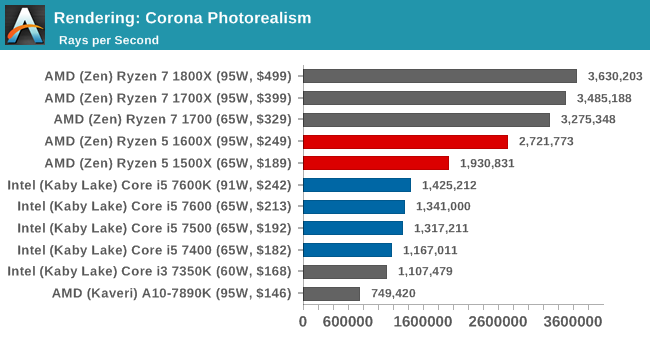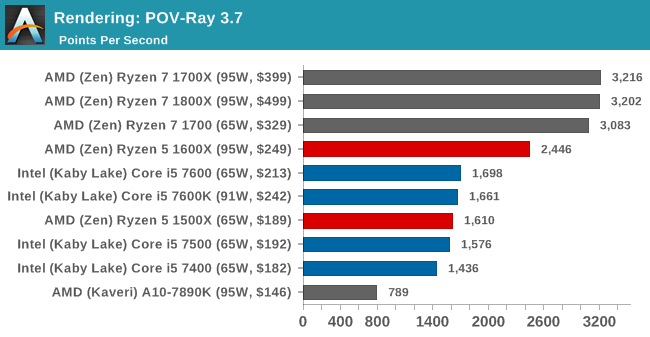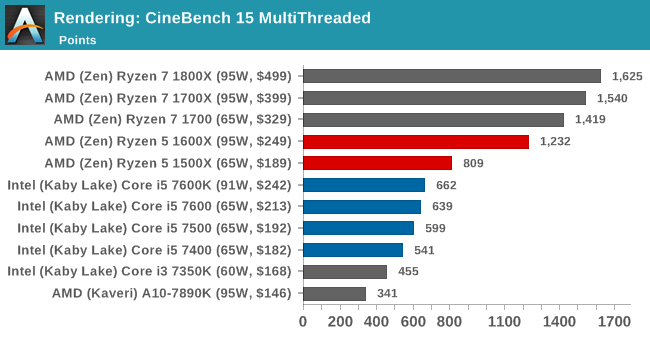The AMD Ryzen 5 1600X vs Core i5 Review: Twelve Threads vs Four at $250
by Ian Cutress on April 11, 2017 9:00 AM ESTBenchmarking Performance: CPU Rendering Tests
Rendering tests are a long-time favorite of reviewers and benchmarkers, as the code used by rendering packages is usually highly optimized to squeeze every little bit of performance out. Sometimes rendering programs end up being heavily memory dependent as well - when you have that many threads flying about with a ton of data, having low latency memory can be key to everything. Here we take a few of the usual rendering packages under Windows 10, as well as a few new interesting benchmarks.
Corona 1.3
Corona is a standalone package designed to assist software like 3ds Max and Maya with photorealism via ray tracing. It's simple - shoot rays, get pixels. OK, it's more complicated than that, but the benchmark renders a fixed scene six times and offers results in terms of time and rays per second. The official benchmark tables list user submitted results in terms of time, however I feel rays per second is a better metric (in general, scores where higher is better seem to be easier to explain anyway). Corona likes to pile on the threads, so the results end up being very staggered based on thread count.
Blender 2.78
For a render that has been around for what seems like ages, Blender is still a highly popular tool. We managed to wrap up a standard workload into the February 5 nightly build of Blender and measure the time it takes to render the first frame of the scene. Being one of the bigger open source tools out there, it means both AMD and Intel work actively to help improve the codebase, for better or for worse on their own/each other's microarchitecture.
POV-Ray 3.7.1
Another regular benchmark in most suites, POV-Ray is another ray-tracer but has been around for many years. It just so happens that during the run up to AMD's Ryzen launch, the code base started to get active again with developers making changes to the code and pushing out updates. Our version and benchmarking started just before that was happening, but given time we will see where the POV-Ray code ends up and adjust in due course.
Cinebench R15
The latest version of CineBench has also become one of those 'used everywhere' benchmarks, particularly as an indicator of single thread performance. High IPC and high frequency gives performance in ST, whereas having good scaling and many cores is where the MT test wins out.















254 Comments
View All Comments
vladx - Thursday, April 13, 2017 - link
Yes as someone with both a 7700k system and a 1700X system I can safely call myself unbiased as I hold no special loyalty towards any brand.Cooe - Monday, March 1, 2021 - link
Liar liar, pants on fire lol.cryosx - Thursday, April 13, 2017 - link
they were testing against the direct competition (i5s) and the rest of the ryzen family. Makes sense, though I guess having the i7s in would be a nice touch.Nightsd01 - Wednesday, April 12, 2017 - link
"[Ryzen] has 50% more cores and 200% more threads"Wouldn't it be 300% more threads? 12 threads is 3x more than 4
Outlander_04 - Thursday, April 13, 2017 - link
200% MOREcvearl - Thursday, April 13, 2017 - link
Curious what method on GTAV was used. I get in the 70's at those settings on my RX480 all VH settings on an i7 2600k.ianmills - Thursday, April 13, 2017 - link
Dolphin benchmarks still missing!Notmyusualid - Tuesday, April 18, 2017 - link
@ianmillsI was looking for them too.
msroadkill612 - Thursday, April 13, 2017 - link
Ryzens tough for cheapskates. its a nice cheap 4 core, but gee, for so little more u get a 6 core 1600.msroadkill612 - Thursday, April 13, 2017 - link
zen is just amds first act.The second is naples - gluing multiple ryzens together using their excellent new plumbing.
The third is vega (gpu has long been amdS focus - in a10apuS e.g.).
The last and seismic act, is a ccx with a single zen core block of four cores & same 4mb l3 cache, and a vega gpu, possibly with hbm2 vram.
Its not very new ground for them. its very similar to the architecture solutions needed for the a10.
Incidentally, i heard a great debate about "dark coding?".
coders love using the gpu for compute when they can, cos it shifts heat away from stressed processors. cooler processors can then run faster. IE, they try and shift the load around the circuitry to avoid generating hot spots.
The conclusion omitted to say "if u consider pc software static.... Then buy intel"
new generation and paradigm, or the last tart up of the old generation. Your choice.
There are of course wins and losses by both, but we know that we are measuring the best of the old, with the lowest point of the rapidly improving new. (see ashes of singularitytweak)
& as above, its just act 1 now.
The authors haughty dismissal of amdS top am4 chipset features is outrageously deceptive (as said in posts here).